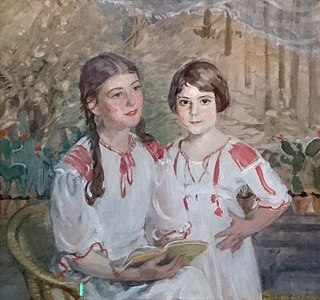Related Research Articles
Arthur Charles Erickson was a Canadian architect and urban planner. He studied Engineering at the University of British Columbia and, in 1950, received his B.Arch. (Honours) from McGill University. He is known as Canada's most influential architect and was the only Canadian architect to win the American Institute of Architects AIA Gold Medal. When told of Erickson's award, Philip Johnson said, "Arthur Erickson is by far the greatest architect in Canada, and he may be the greatest on this continent."
Ronald James Thom, was a Canadian architect. He is well known for two works: Massey College and Trent University's riverside campus.

Cornelia Hahn Oberlander LL.D. was a German-born Canadian landscape architect. Her firm, Cornelia Hahn Oberlander Landscape Architects, was founded in 1953, when she moved to Vancouver.
Barton Myers is an American architect and president of Barton Myers Associates Inc. in Santa Barbara, California. With a career spanning more than 40 years, Myers is a fellow of the American Institute of Architects and was a member of the Ontario Association of Architects while working in Canada earlier in his career.

The Aomori Nebuta Matsuri is a Japanese summer festival that takes place in Aomori, Aomori Prefecture, Japan in early August. The festival attracts the most tourists of any of the country's nebuta festivals, and is counted among the three largest festivals in the Tōhoku region. It was designated an Important Intangible Folk Cultural Property in 1980, and as one of the 100 Soundscapes of Japan by the Ministry of the Environment in 1996.
Siamak Hariri, OAA, AAA, AIBC, FRAIC, RCA, Intl. Assoc. AIA is a Canadian architect and a founding partner of Hariri Pontarini Architects, a full-service architectural and interior design practice based in Toronto, Canada.
Umbra is a home accessories design and manufacturing company. The company has headquarters in Toronto, Ontario, Canada and satellite offices in the Netherlands, Brazil, the United States, and China. The firm sells more than 2,000 home products through over 25,000 retailers in 120 countries.
The Index Project, formerly INDEX: Design to Improve Life, is a Danish nonprofit organisation that promotes designs aimed at the improvement of life worldwide, both in developed and developing countries. The organisation is behind the biennial Index Award, the world's biggest design award.

Bjarke Ingels Group, often referred to as BIG, is a Copenhagen and New York City-based group of architects, designers and builders operating within the fields of architecture, urbanism, research and development. The office is currently involved in a large number of projects throughout Europe, North America, Asia and the Middle East. As of 2021, the company employs 600 people.
KPMB is a Canadian architecture firm founded by Bruce Kuwabara, Thomas Payne, Marianne McKenna, and Shirley Blumberg, in 1987. It is headquartered in Toronto, where the majority of their work is found. Aside from designing buildings, the firm also works in interior design. KPMB Architects was officially renamed from Kuwabara Payne McKenna Blumberg Architects to KPMB Architects on February 12, 2013.

Michael James Audain, is a Canadian home builder, philanthropist and art collector. He is the Chairman and major shareholder of the privately held Polygon Homes Ltd., one of the largest multi-family builders in British Columbia.

5468796 Architecture is a Winnipeg-based architecture practice founded in 2007. The practice name incorporates its company registration number.

Ian Gillespie is a Canadian real estate developer. In 1992 he founded Westbank Projects Corp. based in Vancouver, British Columbia, which now has more than $25 billion of projects completed or under development. The company is active across Canada and expanding into the United States with projects including residential, rental, affordable housing, office, retail, hotels and public art.
Brigitte Shim, FRAIC, OC, RCA, Hon. FAIA, OAA is a Canadian architect known for her small house designs in Canada and other works in architecture of different scales. Shim is a founding partner of Shim-Sutcliffe Architects, along with her husband, Howard Sutcliffe. Before the establishment of Shim-Sutcliffe Architects in 1994, she was a practicing architect who also taught at the University of Toronto's John H. Daniels Faculty of Architecture, Landscape and Design. She continues to guide young designers as a tenured professor at University of Toronto and as a visiting professor to many other institutions until today. Her works span different scales in architecture, ranging from chairs to public facilities. Her work often shows an interest in the relationship between architecture and nature. Her work has garnered awards such as over a dozen Governor General’s Medals for architecture. Shim is an invested officer of The Order of Canada for her significant contributions to the country.
Grace Jeffers is an American writer, historian, educator and artist based in New York. She pioneered and continues to lead an interdisciplinary and integrated approach to the study of materials. Her writings and lectures draw on 20th century art, design and cultural history, emphasizing the intelligent use of synthetic and manmade materials in the practice of design.
softwall is a flexible room divider designed by Stephanie Forsythe and Todd MacAllen of molo. Made from paper or nonwoven polyethylene, the walls use a structured honeycomb geometry to bend, curve, expand and contract. The honeycomb structure also provides acoustic absorption. Part of a modular system, each softwall can connect to another by magnetic end panels. The walls have been used to create booths for trade fairs, pop-up retail, sculptural art installations, backdrops for performances, as well as to divide space in living and working environments.
Softseating fanning stool + bench is a furnishing made from paper or textile, designed by Stephanie Forsythe and Todd MacAllen of molo in 2003 and released in 2006. Internal honeycomb geometry allows the elements to store compressed, and then fan open to form seats and tables. Examples of softseating are held in the Museum of Modern Art, the Art Institute of Chicago and the Cooper Hewitt, Smithsonian Design Museum.

Henry Sears was a Canadian modernist architect, and an urban and gallery planner. He was a founding partner of both Klein & Sears Architects and Sears & Russell Architects Ltd. His work centred around social housing development on a neighbourhood scale. It spanned Canada, the United States and Europe.

The Nebuta Museum Wa Rasse is a city-owned museum near Aomori Station in the city of Aomori in northern Japan. It displays a revolving exhibit of four Nebuta floats from the most recent Aomori Nebuta Matsuri summer festival, alongside media related to the festival. The museum opened in January 2011.

Geoffrey Massey was a Canadian architect and urban planner noted for his modernism-inspired architectural works. He was known for his partnership with architect Arthur Erickson that produced notable designs including the Simon Fraser University, and MacMillan Bloedel Building. As an urban planner Massey was known for his contributions toward pedestrian-friendly densification of Vancouver and development of Granville Island in the city.
References
- ↑ Dunwoody, Catherine (Vol. 10, No. 4, 2007). "A Look Above The Rest". Nuvo, pp. 62-64.
- ↑ "Forsythe + MacAllen (molo)". Alumni Dalhousie. 29 September 2015. Retrieved 3 October 2016.
- ↑ Boddy, Trevor (19 Jan 2007). "A few of Vancouver's finest city builders". the Globe and Mail. The Globe and Mail. Retrieved 28 September 2016.
- ↑ 30 Years of Emerging Voices: Idea, Form, Resonance. New York: Princeton Architectural Press. 2015. p. 256. ISBN 978-1-61689-197-8.
- ↑ Rochon, Lisa (19 May 2004). "Building forms join household functions". The Globe and Mail. Vancouver.
- ↑ Maggarey, Paige (7 May 2011). "Vancouver design firm molo has its big moment". The Globe and Mail. The Globe and Mail. Retrieved 28 September 2016.
- ↑ Proctor, Rebecca (2015). The Sustainable Design Book. London: Laurence King Publishing. p. 158. ISBN 978-1-78067-473-5.
- ↑ Chodikoff, Ian (1 September 2008). "Soft Cell". Canadian Architect. Retrieved 28 September 2016.
- ↑ Louie, Elaine (3 Aug 2011). "Paper, Pleated and Clipped for Shelter". New York Times. Retrieved 28 September 2016.
- ↑ Museum of Modern Art. "The Collection, Paper Softwall". Museum of Modern Art. Retrieved 28 September 2016.
- ↑ Art Institute of Chicago. "Collections, Molo Design Ltd". Art Institute of Chicago. Retrieved 28 September 2016.
- ↑ Cooper Hewitt, Smithsonian Design Museum. "Softseating Stool, 2007". Smithsonian Institution. Retrieved 28 September 2016.
- ↑ "delicate erosion: a study in light and ephemeral space". Centre of Arts Caja de Burgos. Retrieved 28 September 2016.
- ↑ Archello. "Vancouver Art Gallery, Grand Hotel". Archello. Retrieved 28 September 2016.
- ↑ Gardiner Museum. "True Nordic". Gardiner Museum. Retrieved 28 September 2016.
- ↑ Chloë Colchester (2007). Textiles Today: A Global Survey of Trends and Traditions. Thames & Hudson. p. 199. ISBN 978-0-500-51381-1.
Stephanie Forsythe and Todd MacAllen studied architecture at Dalhousie University in Halifax, Nova Scotia. They formed their ... Molo Design was founded in 2003 and their design, Softwall, received the Index Award in 2005.
- ↑ "The International Architecture Awards 2011 Archive" (PDF). Chicago Athenaeum Museum of Architecture and Design. Retrieved 25 September 2016.
- ↑ "Celebrating the winners of the 2011 AR+D Awards". Architectural Review. Architectural Review. 23 Nov 2011. Retrieved 25 September 2016.
- ↑ "Molo". Architectural Record. Architectural Record. 16 Dec 2010. Retrieved 25 September 2016.
- ↑ Lasky, Julie (19 May 2010). "Inside the 2010 ICFF". New York Times. Retrieved 28 September 2016.
- ↑ "MIPIM Architectural Review Future Project Awards (2010)". Arch Daily. Arch Daily. 3 Feb 2010. Retrieved 3 Oct 2016.
- ↑ Rochon, Lisa (19 May 2004). "Building forms join household functions". The Globe and Mail. Vancouver.
- ↑ "The First Step Housing Competition". NY Arts Magazine. NY Arts Magazine. Retrieved 3 Oct 2016.
- ↑ "Lightouch for Forsythe and MacAllen". Canadian Architect. Retrieved 3 October 2016.
- ↑ "2003 Young Architects Forum: Inhabiting Identity". The Architectural League of New York. the Architectural League of New York. Retrieved 3 Oct 2016.
- ↑ "Canadians get AR + d high commendations". Canadian Architect. 27 Jan 2003. Retrieved 3 October 2016.
- ↑ "Made in Japan". Canadian Architect. 1 August 2011. Retrieved 3 Oct 2016.
- ↑ "Forsythe + MacAllen (molo)". Alumni Dalhousie. 29 September 2015. Retrieved 3 October 2016.